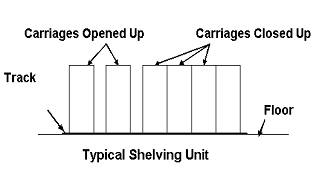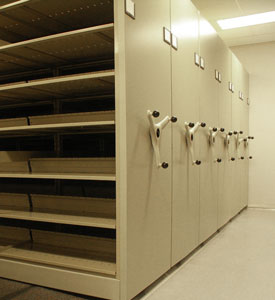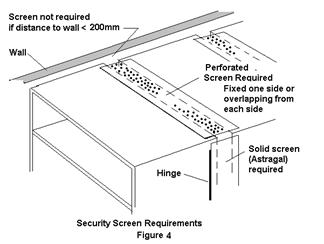Common menu bar links
G1-028 Security Use of Mobile Shelving
Physical Security Guide
Lead Agency Publication G1-028
Issued: September 2005
Table of Contents
- 1. Introduction
- 2. General
- 3. Security Requirements
- 4. Mobile Shelving and Security Containers
- 5. Summary of Modification Requirements for Security
- 6. Security Application Table (Baseline Threats Only)
- 7. Conclusion
- 8. Additional Information/Contacts
- 9. References
1. Introduction
The purpose of this guide is to provide information on the use of mobile shelving units for the storage of sensitive information.
It is imperative that Departmental Security and Real Property personnel be involved at all stages. This will ensure that all aspects of procuring and installing the mobile shelving units are in compliance with codes and regulations concerning security, fire safety and architectural/structural issues.
It is further recommended that all personnel involved in the procurement, installation and modification of mobile shelving read and understand this guide.
The procurement and installation of mobile shelving should not, under any circumstance, be delegated to a procurement agent without support and coordination from both Security and Real Property personnel.
1.1 Determination of Needs
The originator (end user) or the Departmental Security Officer (DSO) must determine the requirements and provide the following information in order to properly apply the provisions of this document:
- the nature of the material to be stored in the mobile shelving;
- the security zoning of the area where the units will be placed; and
- whether or not RCMP approved security containers will be used in conjunction with the mobile shelving.
In most cases, the security zone designation for the area where the mobile shelving will be installed is known to the end user. The DSO should be contacted if the zone is not known or if the provisions outlined in this document require a more secure zone than is available. Where the requirements outlined in this guide require a more secure zone a full re-assessment of requirements and options will be necessary.
1.2 Coordination with Federal Fire Authority: Fire Protection Design Requirements
Currently, there are no off-the-shelf mobile shelving units that conform to the provisions of the Federal Fire Authority (FFA). Fire Protection Design Requirements require modifications as outlined in that document. Contact the Federal Fire Authority for guidance.
This document should be read in conjunction with Fire Protection Design Requirements. References are made in this document to specific provisions of the Federal Fire Authority document where they impact upon the security requirements. While every effort has been made to ensure that this document complements the Federal Fire Authority requirements, officials from the Federal Fire Authority are the final authority for interpretation and application of the Fire Protection Design Requirements. In all cases, fire safety requirements have precedence over security requirements outlined herein.
2. General
The use of mobile shelving is common in government offices and is increasing as space demands continue to rise.
2.1 Description
Mobile shelving is made up of “carriages” which are independent sections secured on a track. These sections can be closed up to reduce space and opened up to access the shelving of a particular carriage. Typically, each carriage is configured with shelving for the open storage of documents. However, these units can also be used to hold security containers (filing cabinets and safes).

2.2 Use with Approved Security Containers
It is permissible to place approved security containers1 in mobile shelving units subject to weight and size considerations. The mobile shelving vendor and facilities engineering staff should be contacted for guidance when considering this option. Security containers retain their original security classification when placed in a mobile shelving unit as long as the shelving unit is in the appropriate zone specified for that container.
2.3 Required Information
The following information must be provided by the end user or departmental security staff in order to apply this guide:
- the zone in which the shelving unit will be located;
- the classification of information to be stored; and
- whether or not approved security containers will be used.

Figure 1
3. Security Requirements
3.1 Commercial off the Shelf (COTS) Usage
If used as typically supplied, with a commercial lock that engages when the units are fully closed together, mobile shelving will satisfy “Lock Up” criteria and is approved for the storage of Protected A and Protected B information. See “Lock up Requirements for Protected A and Protected B Information”.
However, the Federal Fire Authority Fire Protection Design Requirements calls for units to have a 100 mm clearance between carriages when closed. As a result of clearance, the unit is effectively open shelf storage. Open shelf storage of sensitive information (other than Protected A and Protected B information, which can be secured in a locked room as per “Lock up Requirements for Protected A and Protected B Information) is not acceptable unless the unit is located within a secure room, and therefore effectively within an approved security container. In all cases where mobile shelving has been modified to meet Federal Fire Authority requirements, the use of mobile shelving to store sensitive documents is subject to the modifications/conditions that follow. Contact the end user or DSO for guidance on security containers and security zones and to know the security zone of the area where the mobile shelving will be located.
3.2 Modifying Procedures for Storage of Protected A, Protected B and Confidential Information
Where a mobile shelving unit that has been modified to meet Federal Fire Authority requirements is not located in a locked room, the mobile shelving unit is approved for the storage of unclassified information only, and must be further modified by the addition of security screens or bars called astragals to close the gaps between carriages. The side astragals should be solid steel or aluminum, while the top astragals must be perforated to allow water to penetrate (see Figure 2).

Because solidly fixed metal astragals could create a pinching hazard while the carriages are being closed, it is recommended that the side astragals be attached on a spring-retained hinge that is normally kept rotated flush against the carriage body by the spring. This must be manually rotated to cover the gap and attach the lock (see Figure 3). The hasp can be either integral to the astragal (Figure 2 - option 1) or separate (figure 2 - option 2).


The Federal Fire Authority requirements allow a perforated screen across the top, provided that the holes measure at least 6.4 mm in the least dimension, and the amount of openings constitutes a minimum of 70% of the area of the material.
When mobile shelving is modified to incorporate astragals/screens in accordance with the requirements as outlined above, and an approved combination lock is used, the mobile shelving is then approved for the storage of Protected A, Protected B and Confidential information.
4. Mobile Shelving and Security Containers
4.1 Using Approved Security Containers with Mobile Shelving
As mentioned in the General section, approved security containers can be placed in mobile shelving units and retain their original security classification as long as the mobile shelving unit is in the appropriate security zone (or better) specified for the security container.
5. Summary of Modification Requirements for Security
Cabinet (carriage) - the entire perimeter (all sides except inside shelf face) of the carriage must be constructed so that no part may easily be removed without damaging the container or leaving evidence of entry. Steel rivets are preferred when fasteners must be exposed to the exterior of the cabinet. Screws, if used, must have the heads drilled to prevent removal.
Hasp - An Abloy PL200 is recommended. It should be attached with steel rivets or screws with the heads drilled to prevent removal.
Lock - S&G series 8077 combination padlock required for the storage of Classified information. Any commercial key or combination lock is acceptable for the storage of Protected A information and Protected B information (subject to a TRA).
Side Astragals - minimum 14-gauge steel plates. Preferably on spring-retained hinges.
Top Screen - minimum 14-gauge steel plates with perforations that measure at least 6.4 mm in the least dimension and the amount of openings constitutes a minimum of 70% of the material.
6. Security Application Table (Baseline Threats Only)2
| Zone | Unmodified (COTS) |
Modified to Fire Design Requirements (100 mm gap when closed) (open shelving) |
Further modified to security requirements (astragals and locks) |
|---|---|---|---|
| Operations | Protected A and Protected B (“Locked Up”) | Unclassified only | Confidential, Protected A and Protected B |
| Security | Protected A | ||
| High Security | Protected B (subject to TRA) | ||
| within secure rooms3 | |||
| SR-1 (Sec Room C) |
Protected B and Confidential | Security modifications not required | |
| SR-2 (Sec Room B) |
To Top Secret and Protected C (subject to TRA) | ||
7. Conclusion
Many purchasers treat mobile shelving units as they would office furniture. In fact, they require the expert input of security, fire safety and engineering personnel. Facility departments should coordinate the procurement and installation to ensure floor loading and utility connections meet code requirements, and that the units are appropriately modified to meet both security and the Federal Fire Authority requirements. The Facilities department should be involved from the beginning.
7.1 New Purchases
For new purchases, the procurement documents should include a specification for required modifications as part of the original procurement, ideally written in NMS (National Master Specification) format. Facilities personnel are generally conversant with this format and are familiar with associated issues relating to mobile shelving installation (e.g., floor loading, sprinkler modifications, etc) which should be addressed in the specification. Alternately, the manufacturer may be requested to quote on the provision of a product conforming to the requirements in this document. This option is only recommended if the procurement agent is fully familiar with security requirements and associated technical details, in order to be able to determine if the manufacturer’s proposal fully meets the requirements. The procurement contract should contain a clause indicating that the manufacturer must provide a warranty that the shelving unit meets Federal Fire Authority and RCMP fire and security requirements and that any necessary alterations after delivery/setup will be at manufacturer cost.
7.2 Retrofits and Warranties
For retrofits to existing units, a small work order through the Real Property division should be the simplest route, and is recommended – again, to ensure compliance with all related fire and structural requirements.
Consideration should always be given to warranty issues before any modifications are made. Contact the manufacturer for warranty information and advice before initiating any modifications.
8. Additional Information/Contacts
- For assistance regarding these security recommendations for mobile shelving units – contact the RCMP Technical Security Branch (RCMP.LSA-GRC.POSM@rcmp-grc.gc.ca)
- For questions regarding fire protection requirements and interpretation of Fire Protection Design Requirements, – contact the HRSDC / Federal Fire Authority
- For procurement advice and information on the National Master Specification (NMS) – contact PWGSC. See also: http://www.tpsgc-pwgsc.gc.ca/biens-property/ddn-nms/questions-eng.html.
9. References
- Operational Security Standard on Physical Security (OSSPS)
http://publiservice.tbs-sct.gc.ca/pubs_pol/gospubs/TBM_12A/osps-nosm_e.asp - Mobile Shelving - Fire Protection Design Requirements
http://www.hrsdc.gc.ca/eng/labour/fire_protection/index.shtml - Government Security Policy
http://publiservice.tbs-sct.gc.ca/pubs_pol/gospubs/tbm_12a/gsp-psg_e.asp - “Lock up” requirements for Protected A and Protected B information (under STORAGE section)
http://www.rcmp-grc.gc.ca/tsb-genet/seg/html/home_e.htm
Endnotes
1 Approved security containers are safes, filing cabinets and other containers that have been tested and approved for the storage of sensitive information to the level specified in the security rating when located in the specified security zone or better.
2 Baseline threats are defined in the Operational Standard on Physical Security as the mandatory provisions of the Government security policy and its associated operational standards and technical documentation. The baseline threats are those common to all government departments. For all special cases, a TRA must be conducted. Contact the Departmental Security Officer (DSO) for guidance.
3 A Secure Room SR-2 (formerly Secure Room “B”) is approved for the open shelf storage of all classified material (to Top Secret) and for Protected “C” material – subject to a TRA and suitable access controls. A Secure Room SR-1 (formerly Secure Room “C”) is approved for the open shelf storage of material classified to Confidential, as well as Protected A and Protected B. Construction of a Secure Room must conform to the RCMP Specifications for Secure Rooms. See: http://www.rcmp-grc.gc.ca/physec-secmat/pubs/phys-sec/index-eng.htm for links to specifications (Guide).

